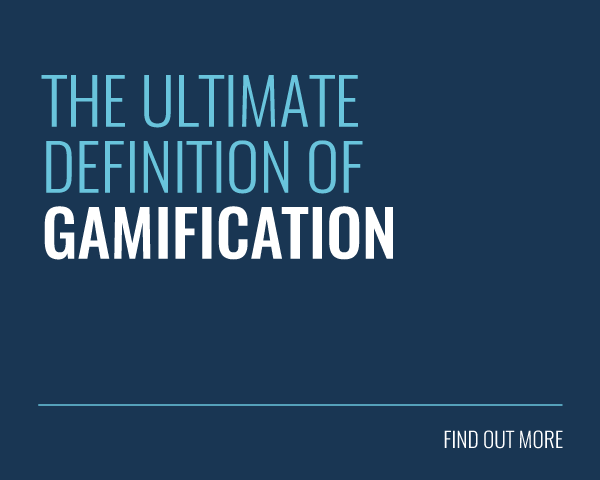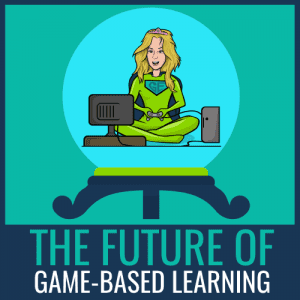 Did you know that it’s not even been 15 years since the word ‘gamification’ was first uttered? You might have seen it in your Facebook feed back then… if Facebook had been invented! To think, we haven’t even celebrated the tenth birthday of the iPhone yet!
Did you know that it’s not even been 15 years since the word ‘gamification’ was first uttered? You might have seen it in your Facebook feed back then… if Facebook had been invented! To think, we haven’t even celebrated the tenth birthday of the iPhone yet!
Technology is shooting ahead faster than we can keep up with it and the world of learning games is no exception. The future of game-based learning is right on our doorstep and if you’re wondering how you’re going to stay on the cutting edge, preparation is half the battle.
So, become a techno-scout and be prepared! To help you earn your badges, we’ve travelled through time to help uncover the top ten things to look forward to in game-based learning.
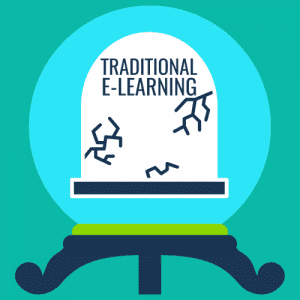 1. Traditional eLearning Dies
1. Traditional eLearning Dies
Because it’s just not up to the task of training people in today’s connected world, the traditional slideshow eLearning model will all but cease to exist. Aside from the challenge of engaging people with this kind of eLearning, it’s inherent inflexibility will spell its downfall.
As Simon Berg of Ceros says: “…you simply require multiple experiences based on how people are interacting with your content. The idea of a one-size-fits-all model for designing content is completely broken.”
 2. More Research into GBL is Conducted
2. More Research into GBL is Conducted
Game-based learning has been a subject of research since the early 20th century. With the advent of computers came a revived interest in the potential of digital learning games. As of 2016, a significant body of research exists that shows how effective game-based learning can be compared to other methods.
However, it has been recognised that much more is needed if we are to understand how exactly it works: “…it is important we develop a more analytic approach that considers how the different elements that operate within video games impact in an educational setting.”*
*Perrotta, C., Featherstone, G., Aston, H. and Houghton, E. (2013). Game-based Learning:
Latest Evidence and Future Directions (NFER Research Programme: Innovation in Education).
 3. Game based learning Becomes the Standard Training Method
3. Game based learning Becomes the Standard Training Method
As more research uncovers the mechanics behind successful game-based learning, learning managers will be in a better position to deliver effective learning games.
As more of these initiatives prove successful, Game-Based Learning will make up a greater share of the learning programme as a whole. Trends in the game-based learning market reflect this with compound annual growth rate in this sector forecasted at 8.3%.
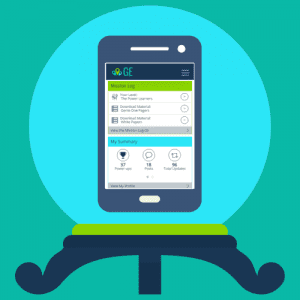 4. Game-Based Learning Shifts Towards Mobile
4. Game-Based Learning Shifts Towards Mobile
In 2008, mobile usage accounted for only 12% of the total consumption of digital media. As of 2015, the tide has turned with 51% of all media being consumed via mobile (eMarketer).
Game based learning will be developed with mobile technology in mind, but it will also adapt to the way people consume content on mobile devices.
 5. “No Time to Learn” Stops Being a Valid Excuse
5. “No Time to Learn” Stops Being a Valid Excuse
Today, people are bombarded with many more outlets and ways to consume media than ever before. To deal with the way people access media today, learning material will be produced in a more bite-sized format.
The success of this format has already been demonstrated by companies like Lynda and Udemy where millions of learners consume content voluntarily on a daily basis.
 6. Learning Games Become More Achievable
6. Learning Games Become More Achievable
As little as 10 years ago, the prospect of creating a game of any kind was a daunting one. Now, major distributors such as Steam include areas that let users create their own game assets.
Game creation applications like Game Maker Studio will continue to improve, unlocking yet more opportunities for the instructional designer to become an amateur game creator. On the other side of the scale, content authoring tools will borrow from game-building software and include more options to build game-based content for learning.
 7. A Greater Focus on Interactivity
7. A Greater Focus on Interactivity
Following on from the success of gamification in learning, and the advances in custom game creation, instructional designers will seek to include more ways for the learner to interact with the learning material. Smaller challenges will also provide more opportunities to deliver instant feedback, giving the learners a clear idea of their progression.
 8. Learner-Led Training for a Consumer-Led World
8. Learner-Led Training for a Consumer-Led World
A learning content strategy based on smaller training assets will make it possible to create more adaptive learning pathways. Learning game designers will consider a more organic, learner-led curriculum structure with various branches open to the learner depending on their abilities and skills.
With this technology available to them, learning content producers will also have a greater freedom to attach a relevant narrative to the learning which bolsters the overall vision and values behind the training.
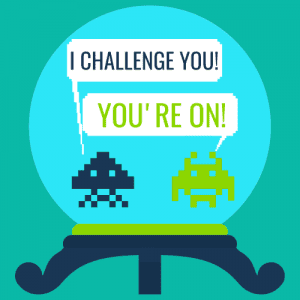 9. Social Gaming Inspires Collaborative Learning
9. Social Gaming Inspires Collaborative Learning
Twitch is a platform that lets gamers watch other gamers play. It might seem like a pointless service, but with 120 million viewers signing on each month, the social element in gaming can’t be ignored.
As broadband speeds improve, learning games will focus more on creating a social gaming experience. Instructional designers will also take inspiration from games like Candy Crush, which require some form of social interaction to proceed through the game.
 10. More Learner activity tracked (engagement measured)
10. More Learner activity tracked (engagement measured)
With a shift to bite-sized mobile learning content, learning managers will re-evaluate the way they measure their learners’ activity. Rather than focusing solely on test results and compliance check-boxes, learners’ rate of engagement will also be measured on a regular basis.
This way, content that doesn’t engage the learners will be highlighted, giving a clearer idea on where the training efforts should be focused.
It’s an exciting time to be working in L&D and, if our predictions are correct, it’s about to get even better! What do you think will be the features that define game-based learning in the next 10 years?
If you fancy yourself as an amateur soothsayer, drop us a Tweet and give us your own predictions!





